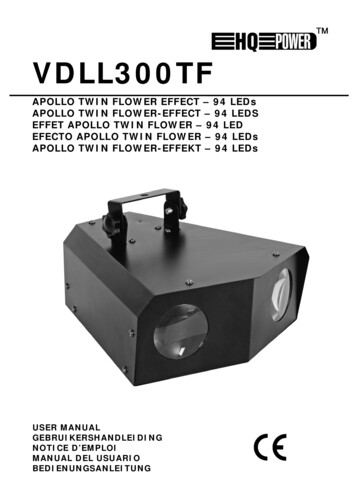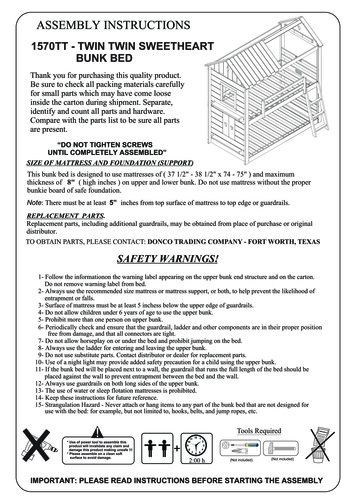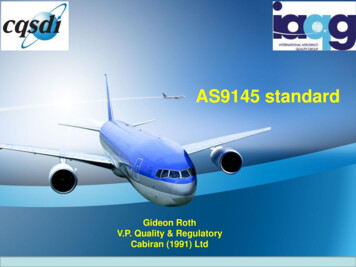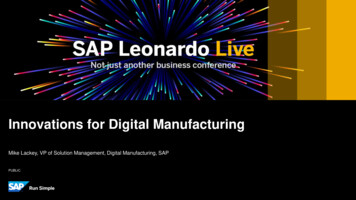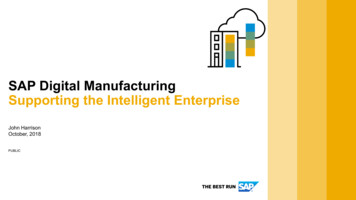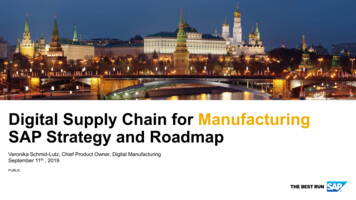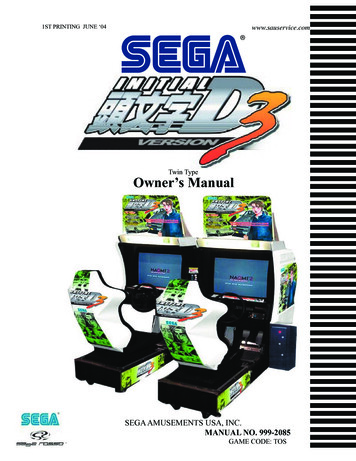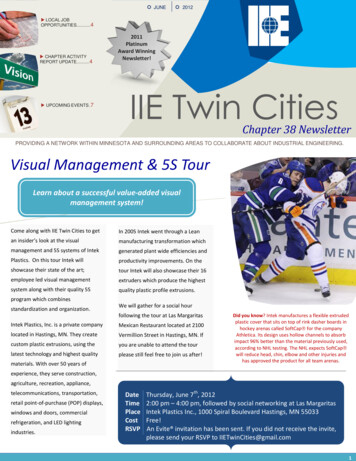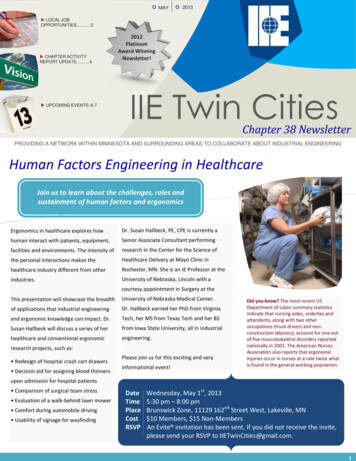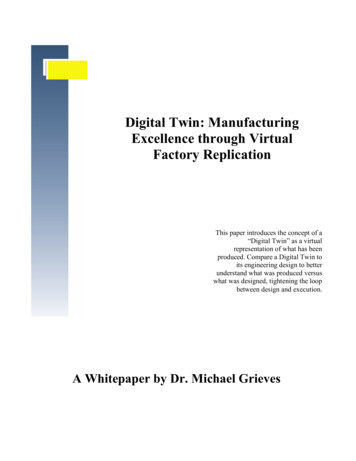
Transcription
Digital Twin: ManufacturingExcellence through VirtualFactory ReplicationThis paper introduces the concept of a“Digital Twin” as a virtualrepresentation of what has beenproduced. Compare a Digital Twin toits engineering design to betterunderstand what was produced versuswhat was designed, tightening the loopbetween design and execution.A Whitepaper by Dr. Michael Grieves
IntroductionThe concept of a virtual, digital equivalentto a physical product or the Digital Twin 1was introduced in 2003 at my Universityof Michigan Executive Course on ProductLifecycle Management (PLM). At the timethis concept was introduced, digitalrepresentations of actual physical productswere relatively new and immature. Inaddition, the information being collectedabout the physical product as it was beingproduced was limited, manually collected,and mostly paper-based.In the decade that has followed, theinformation technology supporting boththe development and maintenance of thevirtual product and the design andmanufacture of the physical product hasexploded.Virtual products are rich representations ofproducts that are virtuallyindistinguishable from their physicalcounterparts. The rise of ManufacturingExecution Systems on the factory floor hasresulted in a wealth of data collected andmaintained on the production and form ofphysical products. In addition, thiscollection has progressed from beingmanually collected and paper based tobeing digital and being collected by a widevariety of physical non-destructive sensingtechnologies, including sensors and gauges,Coordinate Measuring Machines, lasers,vision systems, and white light scanning.1I introduced the term “Digital Twin” inVirtually Perfect: Driving Innovative andLean Products through Product LifecycleManagement (pg. 133). I attributed it toJohn Vickers of NASA whom I work with.We have subsequently used this term incurrent projects.Page 1 of 7Copyright Michael W. Grieves, LLC 2014In light of these advances, it is timely toexplore how the Digital Twin can movefrom an interesting and potentially usefulconcept that aids in understanding therelationship between a physical productand its underlying information to a criticalcomponent of an enterprise-wide closedloop product lifecycle. These tasks willboth reduce costs and foster innovation inthe manufacture of quality products. 2Digital Twin ConceptModelThe Digital Twin concept model is shownin Figure 1. It contains three main parts: a)physical products in Real Space, b) virtualproducts in Virtual Space, and c) theconnections of data and information thatties the virtual and real products together.In the decade since this model wasintroduced, there have been tremendousincreases in the amount, richness, andfidelity of information of both the physicaland virtual products.On the virtual side, we have improved theamount of information we have available.We have added numerous behavioralcharacteristics so that we can not onlyvisualize the product, but we can test it forperformance capabilities.We have the ability to create lightweightversions of the virtual model. This means2While the focus of this paper is on themanufacturing phase, the use of the DigitalTwin extends throughout the product’s lifeto provide value to its user andinformation on how it actually performedto its manufacturer. This larger use isdescribed in Virtually Perfect.Digital Twin White Paper
that we can select the geometry,characteristics, and attributes that werequire without carrying aroundunnecessary details. This dramaticallyreduces the size of the models and allowsfor faster processing.These light-weight models allow today'ssimulation products to visualize andsimulate complex systems and systems ofsystems, including their physical behaviors,in real-time and with acceptable computecosts.These lightweight models also mean thatthe time and cost of communicating themelectronically is substantially less. Theynow can be shared not only with theorganization but also throughout thesupplier network. This enhancescollaboration in both reducing time tounderstand and enhancing both quality anddepth of understanding of productinformation and changes.As importantly, we can simulate themanufacturing environment that createsthe product, including most operations,both automated and manual, that constitutethe manufacturing process. Theseoperations include assembly, roboticwelding, forming, milling, and othermanufacturing floor operations.On the physical side, we now collect moreand more information about thecharacteristics of the physical product. Wecan collect all types of physicalmeasurements from automated qualitycontrol stations, such as CoordinateMeasuring Machines (CMMs). We cancollect the data from the machines thatperform operations on the physical part tounderstand exactly what operations, atwhat speeds and forces, were applied. Forexample, we can collect the torquereadings of every bolt that attaches a fuelpump to an engine in order to insure thateach engine/fuel pump attachment issuccessfully performed.Extending ModelLifespans – A Matter ofUnifying the Virtual andReal WorldsThe amount and quality of informationabout the virtual and physical producthave progressed rapidly in the last decade.The issue is that the two-way connectionbetween real and virtual space has beenlagging behind.Global manufacturers today either workwith the physical product or with thevirtual product. We have not developedthe connection between the two productsso that we can work with both of themsimultaneously.The typical way we do this is to develop afully annotated 3-D model. We thendevelop a manufacturing process that willrealize this model with a Bill of Process(BOP) and Manufacturing Bill ofMaterials (MBOM). The moresophisticated and advanced manufacturersthen simulate the production processdigitally.Page 2 of 7Copyright Michael W. Grieves, LLC 2014Digital Twin White Paper
However, at that stage, we then simplyturn over the BOP and MBOM tomanufacturing and leave the virtualmodels behind. In many cases currently,we even dramatically water down theusefulness of the model by producing 2-Dblueprints for the factory floor.There are manufacturers who are bringing3-D models to the factory floor by way ofterminals stationed in the work cells.However, even here there is not realintegration and connection between thevirtual model and the physical producttaking shape on the factory floor. Theterminal model merely serves as areference, and a human has to perform theconnection between the virtual and thephysical product on an ad hoc basis.As shown in Figure 2, linking the physicalproduct with the virtual product could takethe form of the 3-D model not onlyappearing on the screen but alsoincorporating actual dimensions from thephysical product. The information of thephysical product would overlay the virtualproduct and highlight differences thatwould need to be addressed.This simultaneous view and comparison ofthe physical and virtual product will reapmajor benefits, especially in themanufacturing phase of the product.Page 3 of 7Copyright Michael W. Grieves, LLC 2014Digital Twin FulfillmentRequirementsIn order to deliver the substantial benefitsto be gained from this linkage betweenvirtual and physical products, one solutionis to have a Unified Repository (UR) thatwill link the two products together.Both virtual development tools andphysical collection tools would populatethe Unified Repository. This would enabletwo-way connection between the virtualand physical product.On the virtual tool side, design andengineering would identify characteristics,such as dimensions, tolerances, torquerequirements, hardness measurements, etc.,and place a unique tag in the virtual modelthat would serve as a data placeholder forthe actual physical product. Included in thetag would be the as-designed characteristicparameter.When the design was released forproduction, these tags would be collectedfrom the virtual product model and used tocreate the UR. A lightweight model withthe tags and their characteristics andgeometrical location would also be created.On the physical side, these tags would beincorporated into the MES in the Bill ofProcess creation at the process step wherethey will be captured. As the processeswere completed on the factory floor, theMES would output the capturedcharacteristic to the UR.The final step would be to incorporate thisback into the factory simulation. Thiswould turn the factory simulation into afactory replication application. Instead ofsimulating what should be happening inthe factory, the application would beDigital Twin White Paper
replicating what actually was happening ateach step in the factory on each product.The factory replication application wouldbe in constant communication with the UR,picking up the latest data from actualproduction and displaying it in the virtualfactory.Users could see in near real-time or evenreal time, what actually was occurring onthe factory floor and view the actualproduct characteristics as they were goingthrough production cells.There are a significant number of usecases that can be envisioned from havingsuch a capability.Digital Twin Model UseCasesThe digital twin capability supports threeof the most powerful tools in the humanknowledge tool kit. These three tools are:conceptualization, comparison, andcollaboration. Taken together, theseattributes form the foundation for the nextgeneration of problem solving andinnovation.ConceptualizationUnlike computers, humans do not processinformation, at least not in the sense ofsequential step-by-step processing thatcomputers do. Instead, humans look at asituation and conceptualize the problemand the context of the problem.Humans take in all the data about thesituation there interested in. They thenconceptualize the situation, seeing in theirmind's eye its various aspects. While theycan do this looking at tables of numbers,reports, and other symbolic information,their most powerful and highest bandwidthinput device is their visual sight.Page 4 of 7Copyright Michael W. Grieves, LLC 2014What currently happens is that humanstake visual information, reduce it tosymbols of numbers and letters, and thenre-conceptualize it visually. In the process,we lose a great deal of information, andwe introduce inefficiencies in time.The capability of the digital twin lets usdirectly see the situation and eliminate theinefficient and counterproductive mentalsteps of decreasing the information andtranslating it from visual information tosymbolic information and back to visuallyconceptual information.With the digital twin to build a commonperspective, we can directly see both thephysical product information and thevirtual product information,simultaneously. Instead of looking at areport of factory performance and reconceptualizing how the product ismoving through the individual stations,looking at digital twin simulations allowsus to see the progress of the physicalproduct as it is moving and actually seeinformation about the characteristics of thephysical product.Instead of looking at an array of numberson tolerance measurements, we can look atthe products lined up in the virtual factoryand see the actual trend lines that indicatea problem is developing.Because we have tagged the products withthe designed characteristics, we can selectthose tags and see the designed parametersand the actual parameters simultaneously.ComparisonThe next tool that humans use in assessingsituations is the idea of a comparison. Wecompare unconsciously and continuouslyour desired result and our actual result inorder to determine a difference. We thendecide how to eliminate that difference.Digital Twin White Paper
Comparison is one of most powerfulintellectual tools that we possess.When we have the virtual productinformation and the physical productinformation completely separate, we stillcan do that comparison. However, it isinefficient, as we have to look at thephysical product information, find thecorresponding virtual product information,and then work out the differences.With the digital twin model, we can viewthe ideal characteristic, the tolerancecorridor around that ideal measurement,and our actual trend line to determine for arange of products whether we are wherewe want to be. Tolerance corridors are thepositive and negative deviations we canallow before we deem a resultunacceptable.Depending on how we implemented thiscapability, we could see the differences interms of color, with colors progressingfrom green, “there is no difference,” toyellow, “we are in our tolerance corridor,”to red, “we are beyond the tolerancecorridor.” We can then makeinstantaneous decisions about thedifferences.in the operations of cells further down theline to adjust them to err on the side ofnegative tolerances. Instead ofdegenerating into tolerance stacking, wecould ensure tolerances were distributedaround a mean.The last tool we have is collaboration.CollaborationThe most powerful things that humans dois collaborate with each other in order tobring more intelligence, more variabilityof perspectives, and better problemsolving and innovation to situations. Theproblem with conceptualization as itoccurs without the digital twin model isthat this conceptualization occurs onlywithin the individual. The digital twinmodel allows a shared conceptualizationthat can be visualized in exactly the sameway by an unlimited amount of individualsand by individuals who do not need toshare the same location.We can do this with measurements, tensilestrength, torque readings, and pretty muchany characteristic where we can define thedesired characteristic in some sort of ameasurement, either quantitative or evenqualitative. We can enable this capabilityfor a single product or a range of products.Using the example from above as to trendlines, we could overlay the ideal trend onthe actual trend lines.With the digital twin capability, we canlook at any physical product at any stageon the factory floor and overlay the virtual,product on top of it. This capability ofvirtual products can be extended acrossmultiple factories. This means thatindividuals across the world can not onlylooking at the performance of their ownfactory, but they can be monitoring howthey are doing against factories in otherparts of the world. A problem that arises inone factory can be identified andcontrolled not only in that factory, but thesolution immediately transferred andimplemented in all other factories acrossthe globe.Having this capability, also allows us to dothe comparisons and adjust futureoperations. For example, if we were seeingtolerances on the plus side of our idealmeasurement, we could change parametersIn the past, factory managers had theiroffice overlooking the factory so that theycould get a feel for what was happening onthe factory floor. With the digital twin, notonly the factory manager, but everyonePage 5 of 7Copyright Michael W. Grieves, LLC 2014Digital Twin White Paper
associated with factory production couldhave that same virtual window to not onlya single factory, but to all the factoriesacross the globe.Instead of simply viewing a factorysimulation of what should take place in thefactory, factory replication means that wecan see what is actually taking place onthe factory floor as parts move through thevarious work cells and inspection stations.However, as Figure 2 illustrates, it isexponentially better than simply seeing theprogression and completion of products.We can also see the key designcharacteristics that we are most concernedabout, the actual characteristics we haveachieved, and the gap between the desiredand actual.The digital twin capability with itsconceptualization, comparison, andcollaboration capability frees us from thephysical realm where humans operaterelatively inefficiently. We can now moveto virtual realm where physical location isirrelevant, and humans from across theglobe can have common visualization,engage in comparisons identifying thedifference between what is and whatshould be, and collaborating together. Thisis extremely powerful and only occurs ifwe can match the physical product withthe virtual product.ConclusionOver the last decade, there have beendramatic advances in the capabilities andtechnologies of both the data collection ofthe physical product and the creation andrepresentation of the virtual product, thePage 6 of 7Copyright Michael W. Grieves, LLC 2014Digital Twin. The issue is that while thedata information of each of these areas hasincreased dramatically, the connectionbetween the two data sources has laggedbehind.This white paper has proposed that theconnection between the data about thephysical product and the informationcontained on the virtual product besynchronized. This will open up an entirenew set of use cases.Specifically by merging the virtual productinformation as to how the product is to bemanufactured and the information abouthow the product is actually beingmanufactured, we can have aninstantaneous and simultaneousperspective on how the manufacturedproduct is meeting its design specificationgoals.By using this information, we can changedigital factory simulation, which attemptsto predict how the product is to bemanufactured, into a digital factoryreplication, which shows how the productis actually being manufactured. We canthen compare it against the designspecifications. This can occur in real timeor near real-time. This provides a windowonto the factory floor for anyone at anytime from any place.Focusing on the connection between thephysical product and the virtual productenables us to conceptualize, compare, andcollaborate. We can conceptualize visuallythe actual manufacturing processes. Wecan compare the formation of the physicalproduct to the virtual product in order toensure that what we are producing is whatwe wanted to produce. Finally we cancollaborate with others in our organizationand even throughout the supply chain tohave up-to-the-minute knowledge of theproducts that we are producing.Digital Twin White Paper
Focusing on this connection between thephysical product and the virtual productwill improve productivity, uniformity ofproduction, and ensure the highest qualityproducts.About Dr. Michael GrievesDr. Michael Grieves is a world-renownedauthority on Product LifecycleManagement (PLM). Dr. Grieves haswritten and lectured extensively on thetopic and is a frequent keynote speaker onPLM. Dr. Grieves’ works include theseminal work on PLM, Product LifecycleManagement: Driving the Next Generationof Lean Thinking (McGraw-Hill, 2006)and Virtually Perfect: Driving Innovativeand Lean Products through ProductLifecycle Management (SCP, 2010)Dr. Grieves consults with a number ofleading international manufacturers andgovernmental organizations such asNASA.Dr. Grieves is the Co-Director of theCenter for Lifecycle and InnovationManagement (CLIM) at the FloridaInstitute of Technology and is a ResearchProfessor in the College of Business andthe College of Engineering.Dr. Grieves is Chairman Emeritus ofOakland University’s School of BusinessBoard of Visitors. He has taught in theUnited States, China, and Europe at theuniversity senior undergraduate, andgraduate school levels and has authoredand taught executive education courses. Dr.Grieves is a Professor at CIMBAUniversity, Asolo, Italy with anappointment at the University of Iowa.communications industry. He has been asenior executive at both Fortune 1000companies and entrepreneurialorganizations during his career. Hefounded and took public a nationalsystems integration company andsubsequently served as its audit andcompensation committee chair. Dr.Grieves has substantial board experience,including serving on the board of publiccompanies in both China and Japan.Dr. Grieves has a BSCE from MichiganState University and an MBA fromOakland University. He received hisdoctorate from the Case Western ReserveUniversity Weatherhead School ofManagement.About the SponsorDassault Sys
virtual model and the physical product taking shape on the factory floor. The terminal model merely serves as a reference, and a human has to perform the connection between the virt
